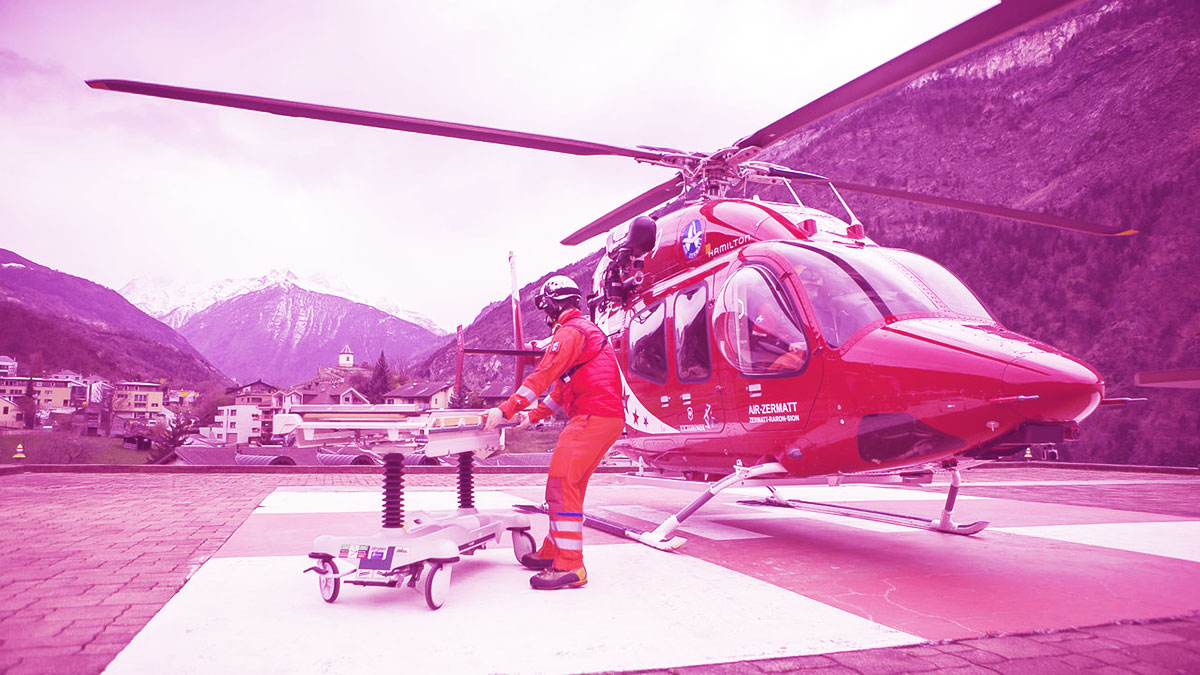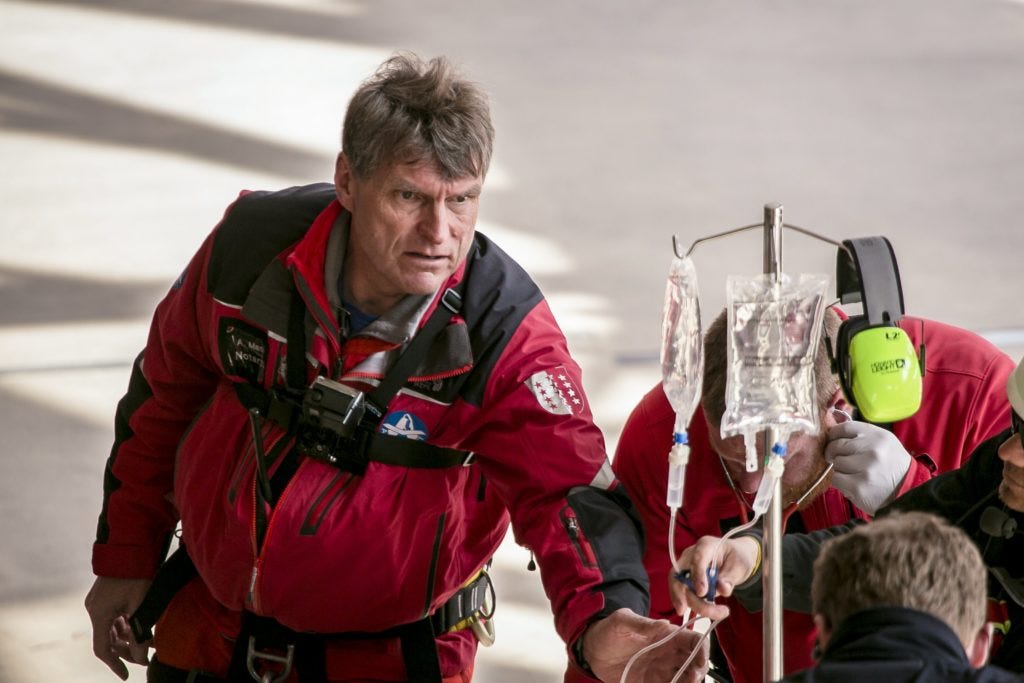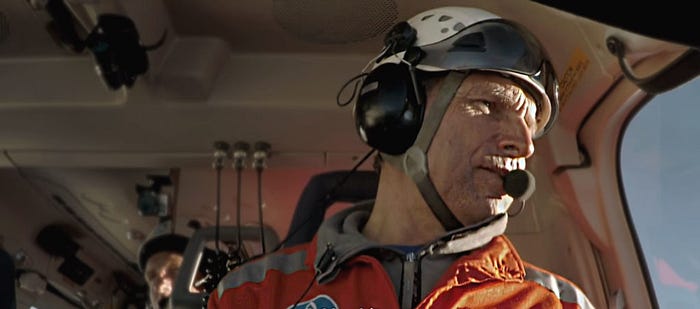-
Url copied to clipboard.
Please note, this article contains subtle spoilers on the Netflix documentary, The Horn.
At our RiskLogic sessions on Business Continuity, Emergency or Crisis Management training, we usually ask what our classes summary on resilience is. Personal experiences mixed with what they’ve read online produces a variety of answers, but we believe we’ve found a visual example of the perfect response.
It’s called The Horn, and it’s a Netflix documentary now available to stream.
In summary, The Horn follows the paramedics and helicopter pilots of Air Zermatt, a specialist rescue organisation located at the base of Switzerland’s famed and ferocious, Matterhorn.

The film crew obtained unprecedented access to the extreme conditions and work that these men and women do, resulting in a dramatic, beautifully shot documentary that can make most jobs feel somewhat…neutral and safe.
I wanted to dive into the key aspects that make it so relevant to what we’re training out and what RiskLogic’s own values are.
I broke it down into five key sections that relate to the six episodes available:
- Team work
- Resilience
- Planning & Training
- Communication
- Passion
If you’ve not seen the documentary yet (stop reading this and go watch it!) and/or have little knowledge of the Matterhorn in Zermatt, here is a quick breakdown:
- Matterhorn height: 4,560m tall (836m taller than New Zealand’s Mount Cook).
- Zermatt ski slopes and tourism: 200km of slopes (21km in summer), 3 million tourists per year.
- Sport undertook in the area: Skiing, snowboarding, hiking, climbing, mountaineering, base jumping, abseiling, hunting, paragliding, heliskiing, sledding, ice-skating and much more.
- Number of rescues: 1,600-1,700 per year (nine available helicopters)
- Fatalities & climbs: 500+ climbers have died on the Matterhorn, 2,000 make the ascent to summit annually.
- Weather: Due to its location and size, it creates its own weather system, making it one of the most challenging rescue locations on earth.
- Rescue range: 2,000 square kilometers
- Staff: 6 full-time and 5 freelance pilots; 5 certified flight instructors, 7 paramedics, and 15 mechanics.
- This year marked their 50th year operating.
1. A Perfect Example of Teamwork
The teamwork Air Zermatt portray is second to none and shown almost immediately in episode one. No more than thirty seconds in, you’re introduced to the extreme conditions these specialist rescuers are put through.
Dangling from a 30ft long rope in a tight crevasse, carefully held and directed from his team above, Simon, a mountain rescue specialist is slowly making his way to his patient. A mountain skier has fallen into one of the most extreme places on earth, and his only way out is from the perfectly rehearsed teamwork the rescuers possess.
Simon is a volunteer and highly rated by his peers as one of the most experienced mountaineers available. He races into Air Zermatt when he is required and called – all year round.
Jumping into the helicopter seconds from taking off, he is briefed and begins preparation. Everything is seamless. The pilot and the paramedics are happy to see Simon again. When they land, he assesses the situation and decides on a plan that everyone trusts and acts upon. Within a few minutes of landing, Simon is meters away from his patient, beginning the procedure and rescue as planned.
Simon Anthamatten of Air Zermatt
Although the scenes after this may be distressing to some, it’s a brilliant ending to episode one that portrays an ultimate level of brotherhood and faith in one another.
Almost every ten minutes within the show, you are introduced to more examples of their impressive teamwork. Episode four introduces you to the junior paramedics who are going through their training. What stuck with me was that their tutor/trainers are paramedics employed by Air Zermatt, not at a University or a training school. The people who taught them will be the people they work alongside. With this, a dynamic but extremely effective routine is set up early on and followed throughout their careers.
“I just need to tell you how amazed I am by the level of teamwork you displayed”, a patient declares to his rescuers.
Everyone knows the drill, there is no question of capability. Everyone seems to know exactly where everyone is, even when they’re 30ft beneath the snow.
2. Resilience
Episode five and six talks of the mission during one of their busiest periods. Air Zermatt is put through extreme conditions regardless of the tourism boom, but in the height of the season, they are seen rescuing 20+ patients a day. With nine helicopters and an average of an hour per rescue, days are long and exhausting. For the team though, not having enough time to finish lunch is the norm, but not being able to complete the mission isn’t.
In one instance, a hiker heads out on an easy, up-and-down route to a pass. Here, he is struck by a devastating white-out that brings with it extreme fog and winds. He pitches his tent right where he stands and assesses the situation; it’s not good. With only a day of food and three days of water, he decides to activate his emergency beacon, Air Zermatt pick this up instantly.
As you’d now expect, the pilots are in the air within minutes, however, they’re confronted by extreme weather and simply can’t get to him. With a small signal, the team can keep in touch with the stranded hiker over the phone, but by day three, his phone dies.
One of the four Air Zermatt helicopters
“This is going to be really tricky. The weather conditions are quite bad this close to the ground. There is no way, I’m sorry, we can’t make it tonight” radios the pilot back to base.
Throughout the three days this mission runs, the team have no choice but to carry on with other rescues while the weather clears. Their minds are on the job, but also with the lost hiker.
“Sometimes, I go home and try to switch off, but my thoughts are still with the patient, stuck on the mountain. I get to sleep in my bed, but he is still there, trying to survive”, explains senior paramedic, Patrick.
Patrick Wenger — Air Zermatt Paramedic
By day four, an exhausted team has no choice but to head up the mountain one more time, they see a break in the fog. Upon approaching, they explain a detailed situation to the French specialist rescue team they had picked up beforehand. Setting them down onto a small ledge, the team begins the search for the tent. It’s here their resilience is shown once more.
Despite the odds and likelihood of a rescue, the team pushes on. Communications are passed throughout the base and plans are put in motion. Paramedics remain on site, pilots prepare to take over the pickup, hospitals are on standby. Everyone has done this before, they are calm and collected.
“They are sometimes called the heroes, although they say they just do their jobs…they changed my life”, says the stranded hiker.
3. Planning & Training
Air Zermatt runs like clockwork after fifty years of operating. They’re dealt with many varieties of situations and seem to have a plan for every one, but we all know that’s not the case. There are simply too many scenarios possible to have an individual plan for each, therefore, you must assess and group them into priority areas.
In one episode, the siren once again sounds throughout the base. A key member of the show, Patrick learns of a patient on route, but soon finds out her status, code blue.
Senior Paramedic and Doctor, Axel Mann.
Code blue is one of the more serious situations the team can deal with. It is a patient who will not survive long enough to get to a hospital and is effectively classed as ‘dead’. The paramedic’s job is to work fast and precise to bring them back.
The patient is brought into the hanger on a stretcher and almost like a rehearsed dance, the six crew get to work in between the docked helicopters.
“OK, everyone pauses. Take a breath. OK, let’s go again…” orders one of the paramedics.
It’s the middle of winter, but the crew are soaked in sweat from their efforts. In the background, mechanics stare and observe the tense moment. The camera crew keeps a distance.
Jump back a few episodes, and you get a glimpse of how the team prepares for this. During a lunch break, the trainee paramedics are called urgently to assist with a seizure case. Slightly confused and disorientated, the two are caught off guard and need to regroup themselves.
Junior Paramedics in an emergency drill
When they enter the hanger, they see senior paramedic Patrick sitting on a chair having a “seizure”. Despite knowing this is a drill, the team take it extremely seriously and grab all the relevant equipment.
“I think that is the best communication you’ve had so far. You kept relaying the steps and did your A.B.C’s. If you keep this up, you can both be great paramedics”, Patrick praises after the session.
For pilots, their job roles are drastically different and require their attention to be on the safety of their colleagues. In the series, every pilot classes the other as “probably the best in the world”, but it’s the training they give themselves that brings that to light.
After 14,000 hours of flying, CEO Gerold is their most experienced pilot and only took the top job on the agreement he could continue to fly. But even he recognises the need to constantly train. In episode four, he is assessed by his colleague and junior on his capabilities.
Despite a flawless assessment, Gerold showed a commitment and standard to all by ensuring he was not exempt from continuous training and preparation.
Air Zermatt CEO, Gerold. Photo credit @POSTAS
His senior status is nothing but a title on paperwork back at base during rescues. Everyone recognizes the need for teamwork and even when this is practiced, it is treated as equal.
4. Communication
It’s next to impossible to pick out one example of communication within the organisation. Each employee speaks at least three languages, they express a constant drive to keep everyone informed and can present themselves on an equal level to their patients during a rescue.
That is of course, to the exception of Axel.
Senior Paramedic and Doctor, Axel Mann.
Their most experienced and senior doctor seems like an older version of The Terminator and is a typical German/Swiss with ‘Mann’ as a surname. Honing a weathered face, strong jaw and large eyebrows, Axel would come across as the last person you would want to attend to you, but you would be wrong.
“Axel is amazing. If you are in trouble and Axel is there helping you, you will be good. I have rarely seen him make any mistakes in the thirty years we have worked together”, CEO Gerold Binor explains.
During one episode, Axel is trying to attend to a young woman who has a concussion from a skiing accident. She is disorientated and confused trying to get free from the stretcher. While trying to do his job, Axel speaks up and orders the lady to listen.
“HEY! Listen to me OK, we’re trying to help you, you need to stay still and let us WORK!” he points and shouts to her.
It’s a mixture of humor and aggression that comes from Axel’s personality, but his approach is effective. He only speaks when it’s necessary, and when he does, everyone listens. His credibility and experience have created a foundation of trust and respect for Axel from his peers. It’s concise, it’s professional and it gets tasks done.
Later in the series, Axel is called upon to assist with multiple rescues on a ski slope. By the fourth rescue, the weather once again sets in. The helicopter leaves with two patients and not enough room for Axel.
His cell phone rings, “Axel, the pilots have said they can’t get back to you, it’s too foggy now, sorry”. “What am I supposed to do, it’s an hour walk back from here”, Axel asks. “Gerold says get creative”, responds the lady at HQ.
Despite his aggressive look and boisterous approach to communication, Axel manages to convince skiers and mountain staff to make a sled, and ski him down. In a hilarious shot of this senior doctor being led down the slope behind skiers, his phone rings again.
“Are you being creative Axel?” the HQ lady asks.
5. Passion
By now, you’ve likely got an idea of their commitment and passion for their roles. A love for their jobs, their colleagues and mission has produced a company that can set an example for the rest of the world. They believe in what they do and are prepared to spend hours perfecting it.
If it wasn’t for the passion for learning, saving and excelling at their jobs, many more lives would be lost on those mountains. This is something we could all learn from.
It was perhaps the last quote by CEO, Gerold that summed it up best.
“All these questions, they arise, and you learn, and you try to figure out the best way for yourself. Mainly it’s a school for life what we do here. Sometimes in a very hard way, but that’s what it’s all about. Being a human being…”

In conclusion…
We were pleased to come across this documentary, not just because of how well it’s put together, but because there is another great example to touch upon when we meet people now. Another case-study that we can use to perfect our own resiliency and revisit to inspire plans and actions.
I highly recommend watching The Horn when you have a chance, but when you do, ensure you concentrate on the key elements that assist them in their jobs: teamwork, maintained by communication, progressed with resiliency and set upon a passion for what they do.
Until next time, plan, do, check and act…












